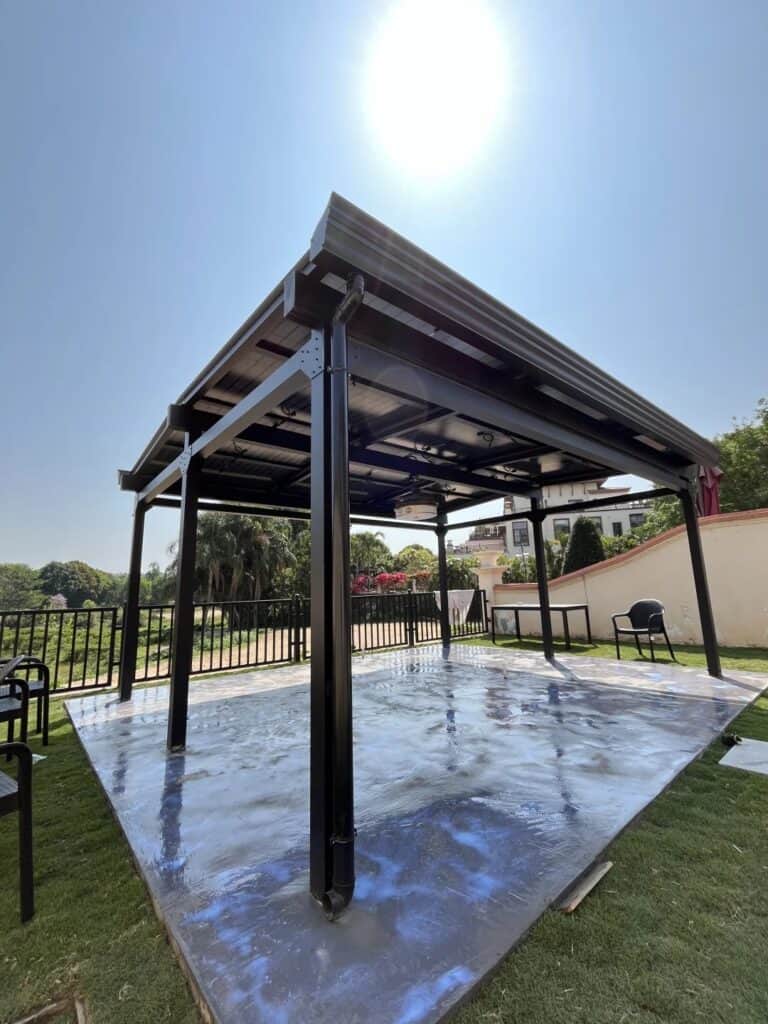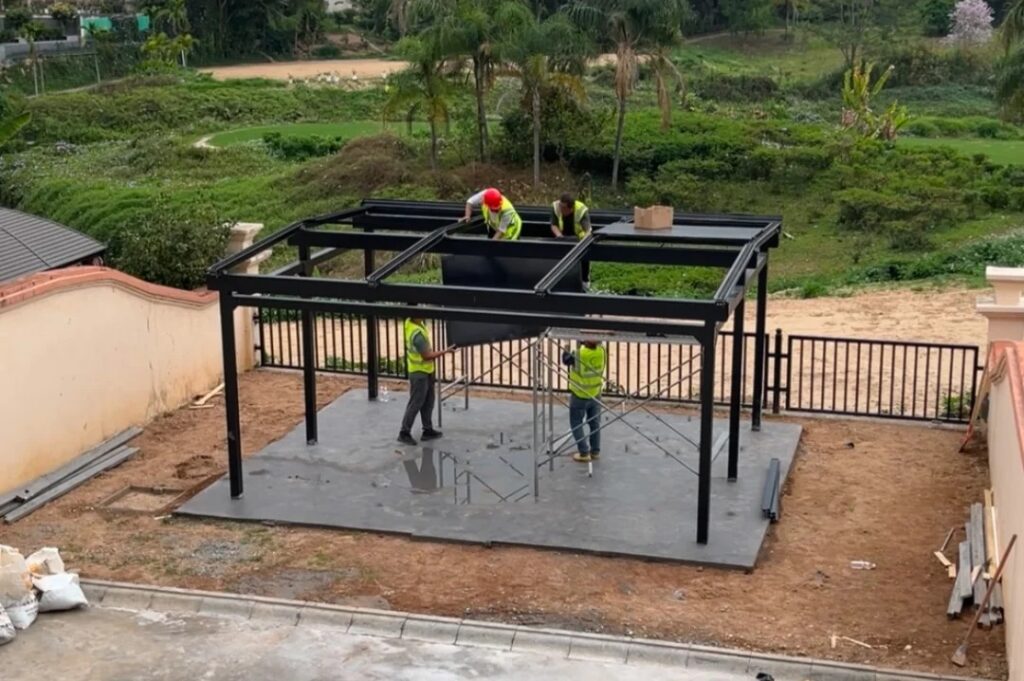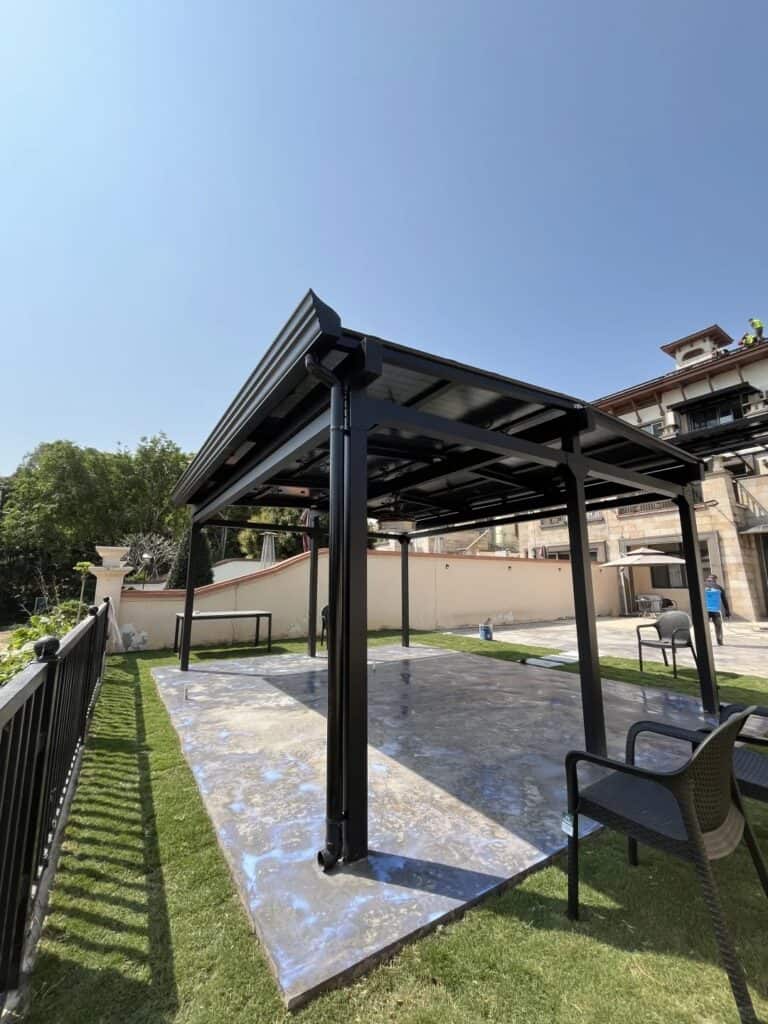Thinking about putting solar panels on your pergola? It’s a creative idea — and one that’s gaining traction as more homeowners explore flexible, space-saving solar solutions.
But turning a pergola into a power-generating structure isn’t just about mounting panels. It involves real questions about sunlight exposure, structural strength, electrical safety, and overall value.
As specialists in steel and photovoltaic structures, we’ve seen the good ideas — and the avoidable mistakes. In this guide, we’ll walk you through what works, what doesn’t, and how to decide whether a solar pergola makes sense for your space.
What to Expect in This Blog:
Is It Even Possible to Install Solar Panels on a Pergola?
Yes, it’s absolutely possible — but not always simple. Today, more homeowners are turning traditional pergolas into solar pergolas, using them as both shade structures and clean-energy systems. Installing solar panels on a pergola is a practical way to generate renewable energy while maximizing outdoor space — but only if the structure is properly designed or reinforced to handle the load.
A typical solar panel pergola setup includes not just the panels themselves, but also mounting rails, wiring, and sometimes microinverters. These components add weight and require stable support. Many standard wooden pergolas aren’t originally built for this purpose, so adding solar panels on top of a pergola may require engineering checks or reinforcements.
If you’re considering this option, ask yourself:
- Is the structure strong enough to support solar panels for a pergola roof?
- Is the roof flat or angled for optimal solar performance?
- Does the pergola sit in an area with maximum daily sunlight?
Some homeowners choose to build from scratch using solar panel pergola kits or custom solar pergola kits, which are designed with wind, snow, and panel weight in mind. These steel or aluminum frames are engineered for long-term durability and are often easier to install than retrofitting an existing wooden pergola.
If your current structure isn’t suitable, upgrading or rebuilding as a dedicated solar power pergola may be the safer — and more efficient — choice for generating clean energy in style.
If your current pergola isn’t suitable, upgrading or rebuilding may be the safer (and more efficient) option.
Will the Pergola Structure Support the Weight of Solar Panels?
That depends — not all pergolas are built to carry extra weight, especially from something like solar panels for a pergola roof.

Imagine a backyard solar panel pergola: it’s not just a stylish feature, it’s also a functional solar shade structure that generates renewable energy. But before enjoying the benefits, you need to make sure the frame can handle the additional load.
A standard solar panel weighs about 18–25 kg (40–55 lbs). Multiply that by several panels, plus mounting hardware, wiring, and wind loads, and suddenly your pergola is carrying much more than vines or string lights. That’s why a dedicated solar panel pergola or a pre-engineered solar pergola shade structure is often designed differently from decorative wooden pergolas.
Wooden pergolas, especially older ones, usually aren’t designed with solar in mind. Even steel pergolas may need reinforcement, depending on beam sizes and spacing.
If you’re not sure, here are a few key things to check:
- Beam Size and Spacing: Thicker beams with closer spacing are better for heavy loads.
- Material Type: Steel or engineered wood outperforms standard timber.
- Post Foundation: Are the posts set in concrete, or just sitting on patio stones?
- Roof Slope & Panel Placement: Tilted solar panels on a pergola roof increase stress, especially under wind uplift.
Pro Tip: When in doubt, get a structural assessment. A structural engineer or solar installer can calculate the load capacity and tell you whether your pergola is safe to upgrade — or whether it’s time to rebuild as a purpose-designed solar pergola shade structure.
Do Pergolas Get Enough Sunlight for Solar Panels to Work?
It depends on where your pergola is — and what’s around it.
You might think, “My pergola gets some sun during the day — that should be enough, right?”
Not always. Solar panels need consistent, direct sunlight for most of the day to generate good output. A few hours of partial sun won’t be enough to justify the investment.
Let’s look at a few common scenarios:
- Pergola in a shaded backyard: If nearby trees or buildings block sunlight for several hours a day, your solar production will drop significantly.
- North-facing pergola (in the northern hemisphere): Panels may not get optimal sun exposure, especially in winter.
- Flat-roof pergola: These can work, but panels might need angled mounting to improve efficiency — especially in regions with low sun angles.
The best-case setup is a south-facing pergola with no shade, ideally placed in an open area. Panels should be tilted at an angle close to your latitude for maximum year-round output.
Still unsure?
You can use a solar assessment tool or ask a solar installer to perform a site analysis. They’ll check how much sunlight your pergola gets throughout the day and year — and whether it’s worth installing panels there.
Is It Safe to Install Solar Panels on a Pergola?
It can be — as long as the system is properly designed and installed.

Remember, you’re adding an electrical system to an outdoor structure. That means safety isn’t just about the pergola holding up — it’s also about protecting your home, your equipment, and your family from electrical risks.
Here are the key safety areas to keep in mind:
- Wiring and Electrical Connections:
Solar panels generate electricity, even on cloudy days. Poor wiring or loose connections can lead to short circuits or even fires. All electrical work should follow your local electrical codes and be done by a licensed professional. - Weatherproofing:
Rain, snow, and humidity can easily damage exposed wiring or connectors if not properly sealed. Outdoor-rated components and waterproof junction boxes are a must. - Wind and Uplift Protection:
In strong winds, panels act like sails. If they’re not securely fastened to the pergola — and if the pergola isn’t anchored well — parts can come loose or fly off. - Permits and Code Compliance:
Many regions require permits for solar installations, especially if they’re part of a structure. This helps ensure the setup meets fire, electrical, and structural codes.
Don’t treat a solar pergola like a DIY weekend project. It may look simple, but it’s a mix of structure, electricity, and weather exposure. A certified solar installer will know how to design a system that’s not just functional, but safe for years to come.
How Much Does It Cost to Install Solar Panels on a Pergola?
In most cases, installing solar panels on a pergola will cost more than a standard rooftop system. Why? Because you’re not just installing panels — you’re either adapting an existing structure or building a new one to support them.
Here’s what goes into the total cost:
- The Pergola Itself:
If you’re building a new pergola designed for solar, this can be a significant part of the budget — especially if it’s made of steel or engineered for structural loads. - Solar Equipment:
Panels, inverters, wiring, mounting systems — these costs are similar to any solar setup. - Structural Reinforcement or Custom Design:
Retrofitting an old pergola may require upgrades to meet safety and load requirements. - Labor and Installation:
Expect higher labor costs due to the custom nature of pergola mounting, including structural checks and more complex electrical routing.
In terms of numbers, costs can range anywhere from $5,000 to $20,000+, depending on your setup. A custom-built solar pergola with high-quality materials and a full solar array will be at the higher end.
That depends on your goals. If you’re simply looking for the fastest return on investment, a rooftop or ground-mounted system is usually more cost-effective. But if you also value outdoor aesthetics, multifunctional use, and want to make use of a space that isn’t otherwise productive — a solar pergola could be a smart long-term upgrade.
Can You Add Solar Panels to an Existing Pergola, or Do You Need a New One?
Good question — and the answer is: maybe. It depends on the condition and design of your current pergola.

If you already have a pergola:
Start by asking a few key questions:
- Is it structurally sound?
Wobbly posts or thin beams likely won’t support the extra weight of solar panels. - What material is it made of?
Steel or engineered wood is better suited for solar upgrades. Older wooden pergolas may need reinforcement. - How is it anchored?
If your pergola is just resting on pavers or decking, it may not be safe for a load-bearing solar system. - Does it get full sun?
If it’s mostly shaded or awkwardly placed, retrofitting might not be worth the effort.
In many cases, retrofitting is possible — but it often involves structural upgrades that can cost as much (or more) than building a new, solar-ready pergola from scratch.
When is building new a better option?
- If your current pergola needs major reinforcement
- If it wasn’t designed with load-bearing in mind
- If you want to optimize sun exposure and layout
Sometimes starting fresh is more efficient, safer, and gives you a better return in the long run. A purpose-built solar pergola can be designed for strength, angle, and aesthetics all at once.
Think of it this way: retrofitting works when your existing structure is already halfway there. If not, rebuilding may save you more headaches down the road.
What Are the Design Options for a Solar Pergola?
Just because it’s functional doesn’t mean it can’t look good. A modern solar pergola can transform your backyard into both a stylish shade structure and a renewable energy source. With today’s design choices, pergola solar panels can be installed in a way that balances efficiency, aesthetics, and budget.
Fully Covered vs. Partially Covered
- Fully Covered Pergola: Offers maximum solar output and full shade — perfect for patios or outdoor seating areas exposed to strong sun.
- Partially Covered Pergola: Uses panels on only part of the roof, creating a lighter, airy feel while still generating power.
Framed Panels vs. Integrated Designs
- Framed Solar Panels: The most common and cost-effective solution. Many homeowners choose a framed solar panel pergola kit, which provides a ready-to-install structure with pre-engineered load support. These pair especially well with modern solar pergola designs or industrial-style builds.
- Integrated Solar Panels: Using solar glass or tile that doubles as the roof surface. This creates a sleek, streamlined look that blends into the pergola itself, though it typically comes at a higher price.
Material and Color Matching
Your solar panel pergola doesn’t have to clash with your outdoor space. Steel frames can be powder-coated to complement your home’s exterior, while wood offers a natural aesthetic when paired with darker trims and pergola solar panels.
Design Insight: Whether you want a bold statement piece or a subtle feature that blends into your garden, a modern solar pergola can be both practical and beautiful — especially if you choose the right balance between coverage, panel type, and frame style.
Should You DIY or Hire a Professional?
It’s tempting — especially if you enjoy building things or want to save on installation costs. But when it comes to a solar pergola, some parts of the project are DIY-friendly, while others really aren’t. Choosing whether to use a solar panel pergola kit or hire professionals depends on your skills, tools, and the complexity of your system.
What You Might Be Able to DIY
- Design Concepts: Sketch layout ideas, decide where the pergola goes, and what style fits your space.
- Site Prep: Clearing the area, pouring a concrete pad, or doing basic landscaping can save time and labor costs.
- Pergola Assembly (Without Panels): If you’re using a pre-engineered solar pergola kit, you might assemble the frame yourself — but only if it’s rated to carry pergola solar panels and withstand local wind or snow loads.
What You Shouldn’t DIY
- Structural Engineering: Load calculations, wind resistance, and anchoring require expert knowledge. Missteps here can lead to collapse or failed inspections.
- Electrical Work: Solar pergola kits still involve high-voltage DC wiring. This must be handled by licensed electricians to ensure safety and compliance.
- Permits and Inspections: Solar projects usually require local permits. Professionals manage the paperwork and make sure your solar pergola passes code inspections.
Pro Tip: Smart DIY is about knowing your limits. Use a solar panel pergola kit to simplify the assembly, but partner with professionals for wiring, engineering, and permitting. This balance keeps your project safe, efficient, and enjoyable.
Final Thoughts
Choosing between a solar canopy vs. pergola comes down to style and function, but a solar panel pergola often gives the best of both worlds — shade and clean energy. From solar panels for gazebo setups to advanced designs where Solarwatt solar panels can be installed on a pergola or carport, options are flexible and growing. A solar pergola shade structure can transform your outdoor space into a sustainable asset.
At SteelPRO PEB, we specialize in steel-framed solar pergolas, canopies, and carports built for durability, safety, and performance. Contact us today for a free design consultation and discover how your pergola can become a power-generating shade solution.

